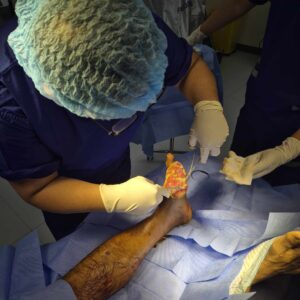Physical therapy treatments have evolved to offer effective solutions for managing pain, restoring mobility, and improving overall performance. Among the innovative techniques available, Instrument Assisted Soft Tissue Mobilization stands out as a targeted approach to address soft tissue restrictions. This guide explains the fundamentals of the technique, its benefits, and what to expect during a treatment session.
Understanding Instrument Assisted Soft Tissue Mobilization
Instrument Assisted Soft Tissue Mobilization is a specialized treatment method used by certified physical therapists to address limitations in soft tissue mobility. By utilizing ergonomically designed instruments, therapists can precisely locate and treat areas of adhesion and scar tissue. These instruments allow for a focused application of pressure, effectively breaking down fibrotic tissue while stimulating the body’s natural healing process.
The technique is based on the principle that microtrauma induced by the instruments creates a controlled inflammatory response. This response helps to clear away inappropriate fibrosis and encourages the remodeling of affected soft tissues. Consequently, the treatment not only helps alleviate pain but also enhances muscle relaxation, range of motion, and overall functional performance.
How the Technique Works
Instrument Assisted Soft Tissue Mobilization involves the use of specialized tools that are specifically engineered for optimal performance. These instruments are designed with ergonomic considerations in mind, ensuring that therapists can apply controlled force with precision. The targeted application helps to break down adhesions and scar tissue that may have formed as a result of injury, surgery, or repetitive strain.
During a treatment session, the physical therapist carefully assesses the patient’s condition and identifies areas of restricted movement. The instruments are then applied to these areas to create a microtrauma. This controlled injury initiates a localized inflammatory response, which in turn promotes the natural healing process. The body reabsorbs the inappropriate fibrosis, leading to a gradual remodeling of the affected soft tissue. Over time, this process results in reduced pain, improved muscle relaxation, and increased mobility.
Key Benefits of Instrument Assisted Soft Tissue Mobilization
Instrument Assisted Soft Tissue Mobilization offers a wide range of benefits for individuals suffering from various musculoskeletal conditions. Some of the primary advantages include:
- Pain Reduction: By breaking down adhesions and scar tissue, the technique helps to alleviate chronic pain. The reduction in tension within the soft tissues often leads to significant improvements in comfort.
- Improved Range of Motion: Scar tissue and adhesions can restrict movement. This treatment facilitates the remodeling of these tissues, allowing for greater mobility and flexibility.
- Enhanced Muscle Relaxation: The application of controlled pressure through the instruments assists in relaxing tight muscles, which can contribute to a reduction in overall discomfort.
- Restoration of Strength: As the treatment improves tissue mobility and reduces pain, patients often experience a gradual return to normal function and strength.
- Effective Treatment for Multiple Conditions: Instrument Assisted Soft Tissue Mobilization is used to treat a variety of conditions affecting both the upper and lower extremities. It is particularly beneficial for injuries caused by repetitive strain, trauma, immobilization, or surgery.
These benefits make the technique an attractive option for individuals looking for a non-invasive approach to managing musculoskeletal issues.
Conditions Treated with Instrument Assisted Soft Tissue Mobilization
This treatment modality is applicable to a range of conditions that involve soft tissue dysfunction. Common issues that can be addressed include:
- Repetitive Strain Injuries: Individuals who perform repetitive tasks, whether at work or during sports, may develop microtrauma that leads to soft tissue restrictions. Instrument Assisted Soft Tissue Mobilization can help alleviate these issues by breaking down adhesions.
- Post-Surgical Rehabilitation: Following surgery, scar tissue can form as the body heals. This technique assists in reducing excessive scar formation and promotes a more functional recovery.
- Trauma Recovery: Accidents and injuries can result in the formation of fibrotic tissue. By targeting these areas, the treatment helps restore normal tissue function and reduces chronic pain.
- Chronic Pain Conditions: Conditions such as plantar fasciitis, tendinitis, and other musculoskeletal disorders often benefit from the targeted approach provided by Instrument Assisted Soft Tissue Mobilization. The technique works to relieve the tension and adhesions that contribute to persistent discomfort.
By addressing the underlying tissue restrictions, the treatment not only offers symptomatic relief but also promotes long-term healing and improved function.
What to Expect During a Session
A typical session of Instrument Assisted Soft Tissue Mobilization is structured and patient-focused. Understanding what to expect can help ease any concerns and enhance the overall experience.
Initial Consultation and Assessment: The process begins with a detailed consultation where the therapist reviews the patient’s medical history and discusses current symptoms. A physical assessment follows to identify specific areas of restriction or pain. This comprehensive evaluation ensures that the treatment is tailored to the patient’s unique needs.
Preparation: Once the problem areas are identified, the therapist explains the procedure, including the type of instruments that will be used and the expected sensations during the treatment. Patients are advised on any necessary pre-treatment steps, such as avoiding heavy physical activity before the session.
Treatment Process: During the session, the therapist uses the instruments to apply controlled pressure on the affected areas. The pressure is adjusted based on the patient’s tolerance and the specific condition being treated. The goal is to induce a mild, localized inflammatory response that will trigger the natural healing process. The treatment is generally well-tolerated, although some patients may experience minor discomfort as the tissues are manipulated.
Post-Treatment Recommendations: After the session, patients receive guidance on post-treatment care. This may include recommendations for stretching, hydration, and modifications to daily activities to support the healing process. Follow-up sessions are scheduled based on the severity of the condition and the patient’s progress.
Monitoring Progress: Over time, patients typically notice a gradual improvement in pain levels and mobility. Regular sessions help ensure that the soft tissues continue to remodel and adapt, leading to lasting benefits.
The structured approach of Instrument Assisted Soft Tissue Mobilization ensures that every session is both effective and safe, paving the way for a more comfortable and active lifestyle.
The Science Behind Instrument Assisted Soft Tissue Mobilization
The effectiveness of Instrument Assisted Soft Tissue Mobilization is supported by an understanding of how the body heals and adapts to injury. When soft tissues are subjected to controlled microtrauma, the body initiates an inflammatory response. This process is a natural part of healing, where the immune system mobilizes to clear damaged cells and stimulate the production of new tissue.
The mechanical pressure applied during the treatment assists in breaking down the adhesions that limit mobility. As the body responds, it begins to remodel the affected tissues. This remodeling not only improves flexibility but also restores the functional alignment of the muscles and connective tissues. Over time, this results in a reduction of chronic pain and an increase in overall strength and performance.
Research in the field of physical therapy continues to shed light on the mechanisms behind soft tissue mobilization. Studies indicate that targeted treatments such as Instrument Assisted Soft Tissue Mobilization can significantly enhance recovery times and reduce the recurrence of injuries. This growing body of evidence has led many professionals to incorporate the technique into standard rehabilitation protocols.
Patient Success Stories
Many individuals have found relief through Instrument Assisted Soft Tissue Mobilization. Patients suffering from long-term pain and restricted movement report noticeable improvements after undergoing the treatment. For instance, one patient described a significant reduction in knee pain following a series of sessions, which allowed them to resume daily activities without the constant discomfort they once experienced.
Another success story comes from a patient recovering from shoulder surgery. The formation of excessive scar tissue had severely limited their range of motion. After incorporating Instrument Assisted Soft Tissue Mobilization into their rehabilitation program, the patient experienced gradual improvements in flexibility and strength, eventually regaining near-normal function.
These real-life examples underscore the practical benefits of the treatment and highlight its potential to transform the recovery process for individuals with varying conditions.
Tips for Maximizing Treatment Outcomes
To get the most out of Instrument Assisted Soft Tissue Mobilization, patients are encouraged to follow these recommendations:
- Follow Post-Treatment Instructions: Adhering to the therapist’s guidelines regarding stretching, hydration, and activity modification can support the healing process.
- Stay Consistent: Regular sessions are key to achieving lasting results. Consistency helps ensure that the tissues continue to remodel and adapt over time.
- Communicate with Your Therapist: Open dialogue about pain levels, progress, and any concerns ensures that the treatment remains tailored to your needs.
- Combine with Other Therapies: When appropriate, combining this treatment with other physical therapy modalities may accelerate recovery and enhance overall outcomes.
- Maintain a Healthy Lifestyle: A balanced diet, regular exercise, and proper rest all contribute to the body’s ability to heal and respond to therapy.
By taking a proactive approach and working closely with a certified therapist, patients can maximize the benefits of Instrument Assisted Soft Tissue Mobilization and pave the way for improved quality of life.
Looking Ahead
Instrument Assisted Soft Tissue Mobilization represents a targeted and effective approach within the field of physical therapy. Its ability to reduce pain, improve mobility, and restore function makes it an attractive option for individuals facing a range of musculoskeletal challenges. As ongoing research continues to validate its benefits, more therapists are adopting this method as part of a comprehensive rehabilitation strategy.
Patients seeking non-invasive treatments for chronic pain or movement restrictions should consider discussing Instrument Assisted Soft Tissue Mobilization with their healthcare provider. With its proven track record and supportive evidence, this technique offers a promising solution for those looking to reclaim an active, pain-free lifestyle.
Takeaway
Instrument Assisted Soft Tissue Mobilization is a valuable tool in modern physical therapy. The technique’s focus on targeting adhesions and scar tissue through controlled mechanical pressure offers significant benefits, including pain reduction, increased range of motion, and improved overall performance. Whether addressing repetitive strain injuries, post-surgical rehabilitation, or trauma-related issues, this treatment has proven effective for a variety of conditions.
Patients interested in exploring this treatment should consult with a certified physical therapist who can provide personalized guidance based on their specific needs. With a commitment to regular sessions and adherence to post-treatment recommendations, many individuals have experienced transformative improvements in their quality of life.
For anyone tired of living with chronic discomfort or restricted movement, Instrument Assisted Soft Tissue Mobilization may be the step forward toward a healthier, more active future. By understanding the science behind the technique, setting realistic expectations, and actively participating in the treatment process, patients can make significant strides toward lasting recovery.
As the field of physical therapy continues to innovate, Instrument Assisted Soft Tissue Mobilization remains a cornerstone treatment, delivering measurable results and empowering patients to move freely and comfortably once again.






